Danish vs Swedish Community Comparison
COMPARE
Danish
Swedish
Social Comparison
Social Comparison
Danes
Swedes
8,781
SOCIAL INDEX
85.3/ 100
SOCIAL RATING
48th/ 347
SOCIAL RANK
8,881
SOCIAL INDEX
86.3/ 100
SOCIAL RATING
41st/ 347
SOCIAL RANK
Swedish Integration in Danish Communities
The statistical analysis conducted on geographies consisting of 464,668,131 people shows a mild positive correlation between the proportion of Swedes within Danish communities in the United States with a correlation coefficient (R) of 0.350. On average, for every 1% (one percent) increase in Danes within a typical geography, there is an increase of 0.123% in Swedes. To illustrate, in a geography comprising of 100,000 individuals, a rise of 1,000 Danes corresponds to an increase of 123.4 Swedes.
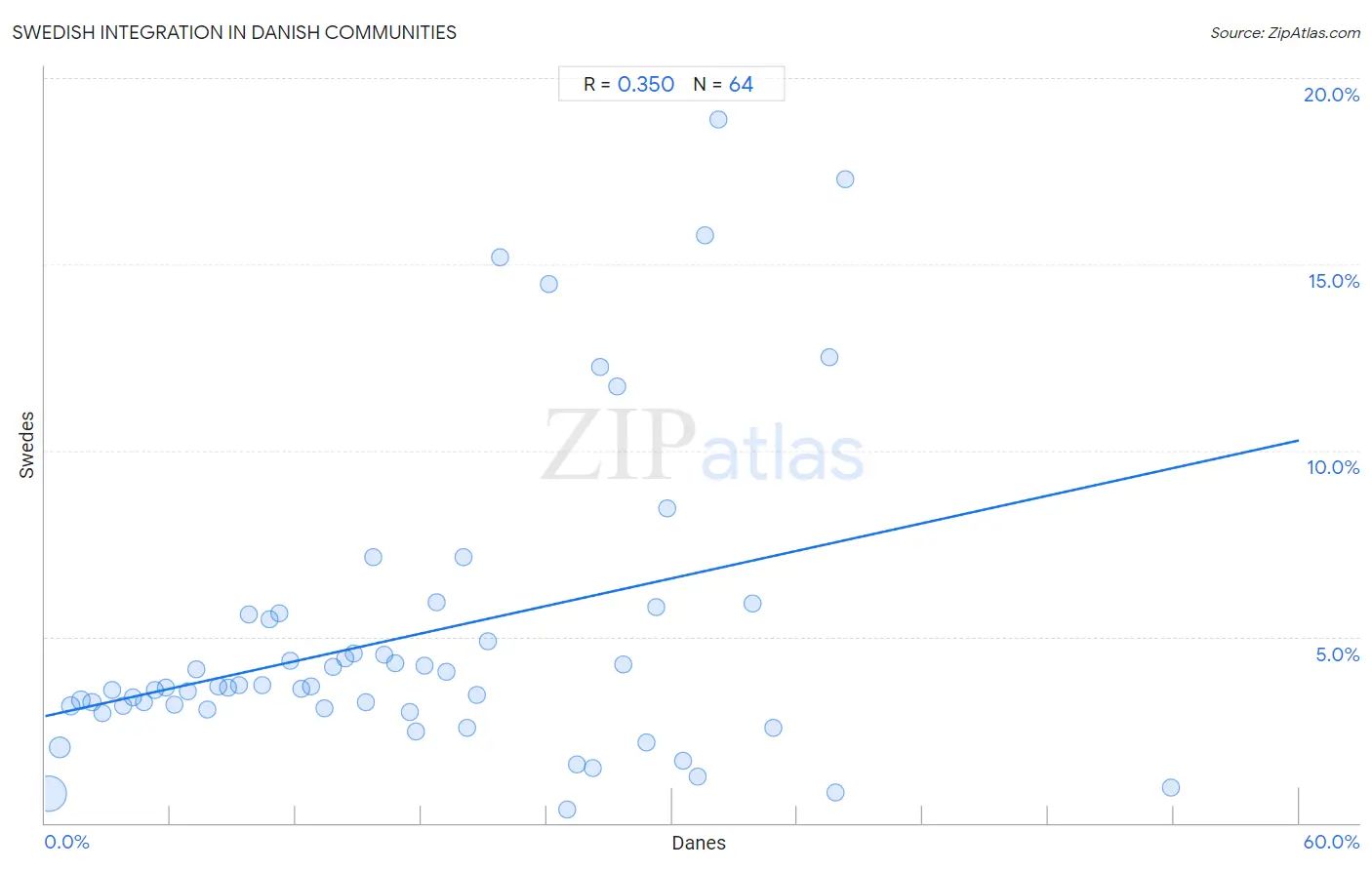
Danish vs Swedish Income
When considering income, the most significant differences between Danish and Swedish communities in the United States are seen in wage/income gap (31.0% compared to 29.4%, a difference of 5.2%), median female earnings ($37,730 compared to $39,421, a difference of 4.5%), and per capita income ($44,095 compared to $45,750, a difference of 3.7%). Conversely, both communities are more comparable in terms of householder income under 25 years ($53,041 compared to $52,986, a difference of 0.10%), householder income over 65 years ($63,117 compared to $62,736, a difference of 0.61%), and householder income ages 45 - 64 years ($105,619 compared to $106,377, a difference of 0.72%).

| Income Metric | Danish | Swedish |
| Per Capita Income | Good $44,095 | Exceptional $45,750 |
| Median Family Income | Excellent $105,900 | Exceptional $108,499 |
| Median Household Income | Excellent $87,676 | Exceptional $88,524 |
| Median Earnings | Average $46,392 | Excellent $47,851 |
| Median Male Earnings | Excellent $56,246 | Exceptional $57,445 |
| Median Female Earnings | Tragic $37,730 | Fair $39,421 |
| Householder Age | Under 25 years | Excellent $53,041 | Excellent $52,986 |
| Householder Age | 25 - 44 years | Excellent $97,221 | Exceptional $99,136 |
| Householder Age | 45 - 64 years | Exceptional $105,619 | Exceptional $106,377 |
| Householder Age | Over 65 years | Exceptional $63,117 | Excellent $62,736 |
| Wage/Income Gap | Tragic 31.0% | Tragic 29.4% |
Danish vs Swedish Poverty
When considering poverty, the most significant differences between Danish and Swedish communities in the United States are seen in married-couple family poverty (4.1% compared to 3.9%, a difference of 7.5%), single father poverty (15.8% compared to 16.3%, a difference of 3.2%), and family poverty (7.3% compared to 7.1%, a difference of 2.5%). Conversely, both communities are more comparable in terms of child poverty among girls under 16 (13.7% compared to 13.7%, a difference of 0.030%), child poverty under the age of 5 (14.9% compared to 15.0%, a difference of 0.20%), and single mother poverty (28.5% compared to 28.4%, a difference of 0.28%).
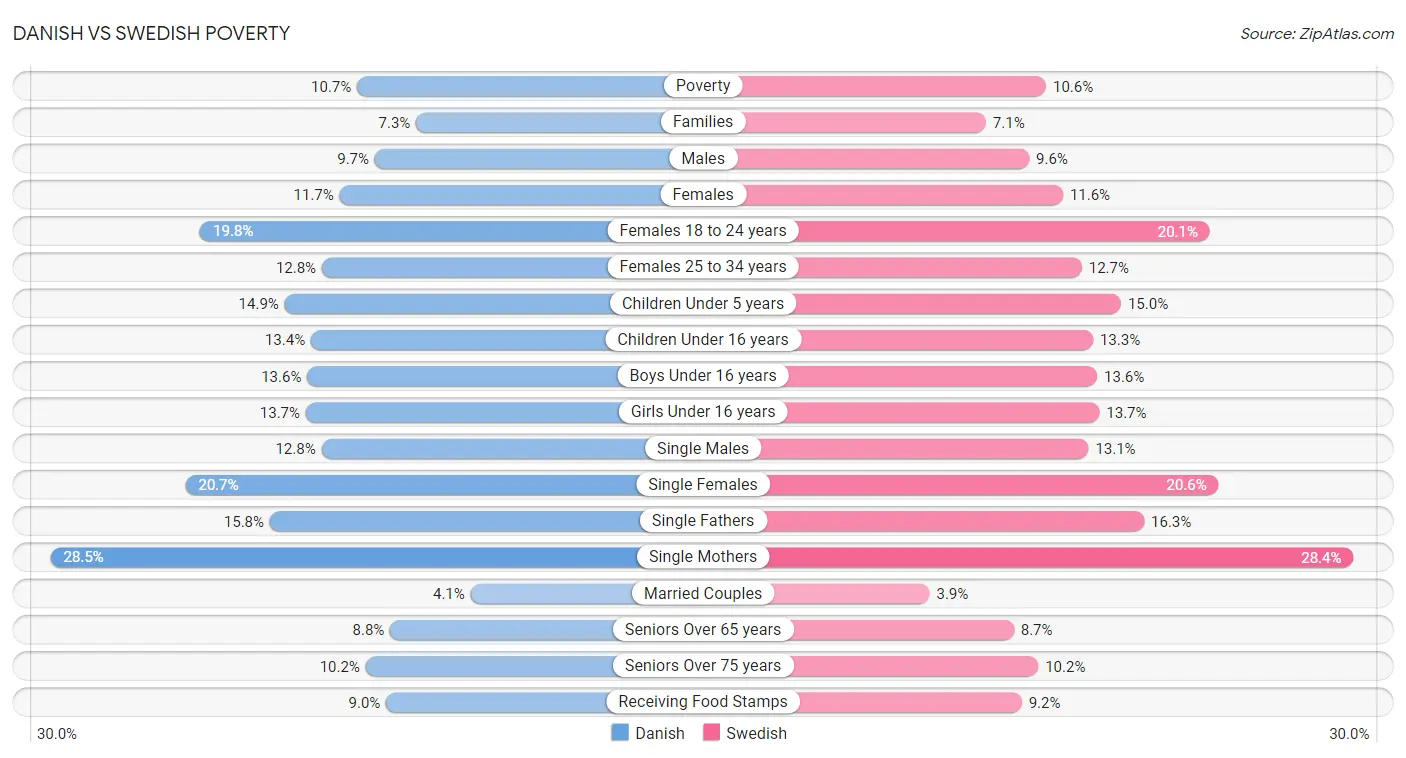
| Poverty Metric | Danish | Swedish |
| Poverty | Exceptional 10.7% | Exceptional 10.6% |
| Families | Exceptional 7.3% | Exceptional 7.1% |
| Males | Exceptional 9.7% | Exceptional 9.6% |
| Females | Exceptional 11.7% | Exceptional 11.6% |
| Females 18 to 24 years | Good 19.8% | Average 20.1% |
| Females 25 to 34 years | Exceptional 12.8% | Exceptional 12.7% |
| Children Under 5 years | Exceptional 14.9% | Exceptional 15.0% |
| Children Under 16 years | Exceptional 13.4% | Exceptional 13.3% |
| Boys Under 16 years | Exceptional 13.6% | Exceptional 13.6% |
| Girls Under 16 years | Exceptional 13.7% | Exceptional 13.7% |
| Single Males | Average 12.8% | Poor 13.1% |
| Single Females | Good 20.7% | Good 20.6% |
| Single Fathers | Exceptional 15.8% | Average 16.3% |
| Single Mothers | Excellent 28.5% | Excellent 28.4% |
| Married Couples | Exceptional 4.1% | Exceptional 3.9% |
| Seniors Over 65 years | Exceptional 8.8% | Exceptional 8.7% |
| Seniors Over 75 years | Exceptional 10.2% | Exceptional 10.2% |
| Receiving Food Stamps | Exceptional 9.0% | Exceptional 9.2% |
Danish vs Swedish Unemployment
When considering unemployment, the most significant differences between Danish and Swedish communities in the United States are seen in unemployment among women with children ages 6 to 17 years (8.1% compared to 8.6%, a difference of 5.6%), unemployment among ages 60 to 64 years (4.4% compared to 4.5%, a difference of 3.7%), and unemployment among women with children under 6 years (7.1% compared to 7.4%, a difference of 3.5%). Conversely, both communities are more comparable in terms of unemployment among seniors over 65 years (4.9% compared to 4.9%, a difference of 0.22%), unemployment among youth under 25 years (10.3% compared to 10.4%, a difference of 0.75%), and unemployment among ages 16 to 19 years (15.2% compared to 15.3%, a difference of 0.87%).
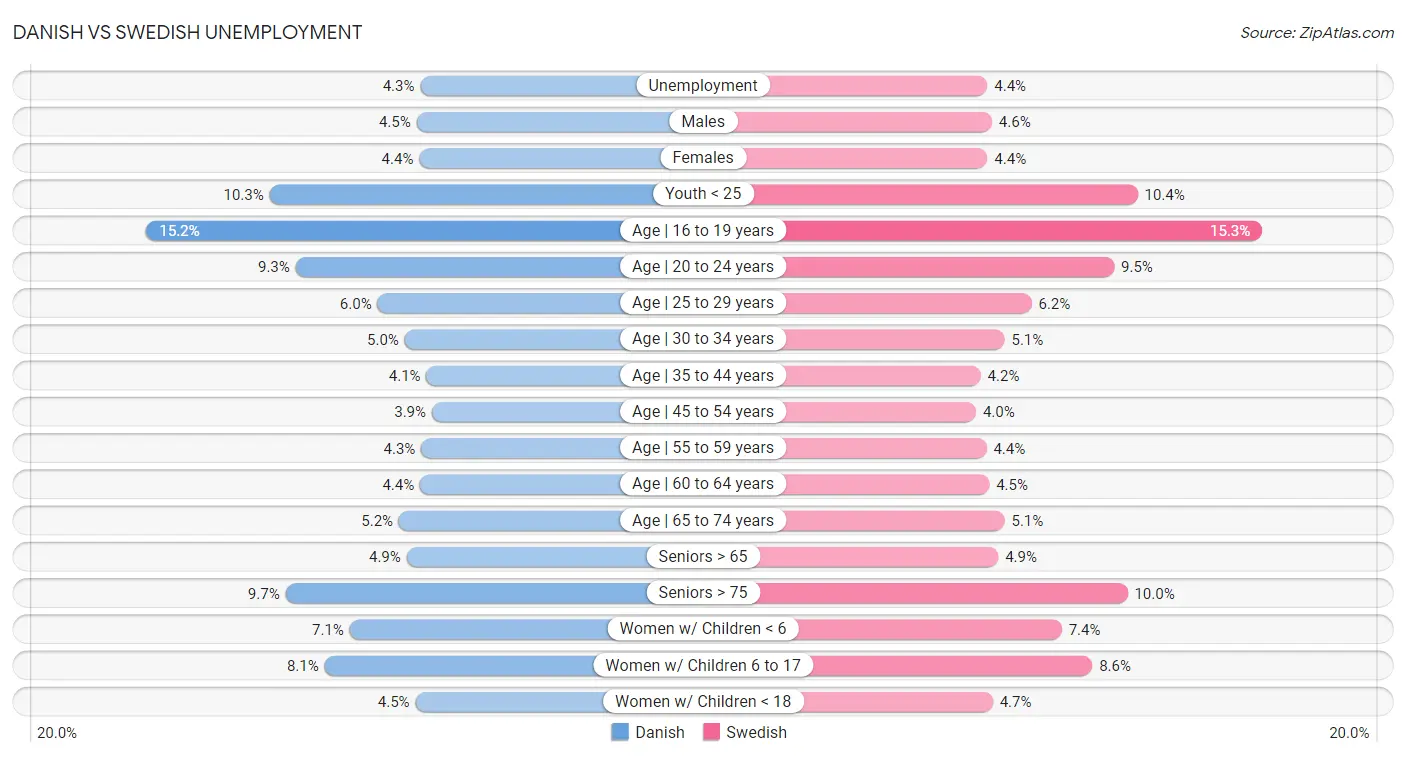
| Unemployment Metric | Danish | Swedish |
| Unemployment | Exceptional 4.3% | Exceptional 4.4% |
| Males | Exceptional 4.5% | Exceptional 4.6% |
| Females | Exceptional 4.4% | Exceptional 4.4% |
| Youth < 25 | Exceptional 10.3% | Exceptional 10.4% |
| Age | 16 to 19 years | Exceptional 15.2% | Exceptional 15.3% |
| Age | 20 to 24 years | Exceptional 9.3% | Exceptional 9.5% |
| Age | 25 to 29 years | Exceptional 6.0% | Exceptional 6.2% |
| Age | 30 to 34 years | Exceptional 5.0% | Exceptional 5.1% |
| Age | 35 to 44 years | Exceptional 4.1% | Exceptional 4.2% |
| Age | 45 to 54 years | Exceptional 3.9% | Exceptional 4.0% |
| Age | 55 to 59 years | Exceptional 4.3% | Exceptional 4.4% |
| Age | 60 to 64 years | Exceptional 4.4% | Exceptional 4.5% |
| Age | 65 to 74 years | Exceptional 5.2% | Exceptional 5.1% |
| Seniors > 65 | Exceptional 4.9% | Exceptional 4.9% |
| Seniors > 75 | Tragic 9.7% | Tragic 10.0% |
| Women w/ Children < 6 | Exceptional 7.1% | Excellent 7.4% |
| Women w/ Children 6 to 17 | Exceptional 8.1% | Exceptional 8.6% |
| Women w/ Children < 18 | Exceptional 4.5% | Exceptional 4.7% |
Danish vs Swedish Labor Participation
When considering labor participation, the most significant differences between Danish and Swedish communities in the United States are seen in in labor force | age 16-19 (44.7% compared to 44.1%, a difference of 1.3%), in labor force | age 30-34 (84.3% compared to 85.2%, a difference of 1.1%), and in labor force | age 25-29 (84.8% compared to 85.6%, a difference of 0.96%). Conversely, both communities are more comparable in terms of in labor force | age 20-24 (79.0% compared to 78.8%, a difference of 0.21%), in labor force | age > 16 (65.3% compared to 65.1%, a difference of 0.25%), and in labor force | age 20-64 (79.9% compared to 80.3%, a difference of 0.42%).

| Labor Participation Metric | Danish | Swedish |
| In Labor Force | Age > 16 | Good 65.3% | Average 65.1% |
| In Labor Force | Age 20-64 | Exceptional 79.9% | Exceptional 80.3% |
| In Labor Force | Age 16-19 | Exceptional 44.7% | Exceptional 44.1% |
| In Labor Force | Age 20-24 | Exceptional 79.0% | Exceptional 78.8% |
| In Labor Force | Age 25-29 | Good 84.8% | Exceptional 85.6% |
| In Labor Force | Age 30-34 | Tragic 84.3% | Exceptional 85.2% |
| In Labor Force | Age 35-44 | Fair 84.3% | Exceptional 85.0% |
| In Labor Force | Age 45-54 | Exceptional 83.3% | Exceptional 83.7% |
Danish vs Swedish Family Structure
When considering family structure, the most significant differences between Danish and Swedish communities in the United States are seen in family households with children (28.7% compared to 27.4%, a difference of 5.0%), births to unmarried women (28.7% compared to 29.6%, a difference of 3.3%), and married-couple households (51.1% compared to 49.7%, a difference of 2.7%). Conversely, both communities are more comparable in terms of single mother households (5.5% compared to 5.5%, a difference of 0.68%), single father households (2.3% compared to 2.3%, a difference of 1.0%), and currently married (50.5% compared to 50.0%, a difference of 1.0%).

| Family Structure Metric | Danish | Swedish |
| Family Households | Exceptional 66.0% | Good 64.5% |
| Family Households with Children | Exceptional 28.7% | Fair 27.4% |
| Married-couple Households | Exceptional 51.1% | Exceptional 49.7% |
| Average Family Size | Tragic 3.17 | Tragic 3.10 |
| Single Father Households | Average 2.3% | Good 2.3% |
| Single Mother Households | Exceptional 5.5% | Exceptional 5.5% |
| Currently Married | Exceptional 50.5% | Exceptional 50.0% |
| Divorced or Separated | Excellent 11.9% | Fair 12.1% |
| Births to Unmarried Women | Exceptional 28.7% | Exceptional 29.6% |
Danish vs Swedish Vehicle Availability
When considering vehicle availability, the most significant differences between Danish and Swedish communities in the United States are seen in 4 or more vehicles in household (8.6% compared to 7.6%, a difference of 12.5%), 3 or more vehicles in household (24.7% compared to 23.0%, a difference of 7.6%), and no vehicles in household (6.6% compared to 6.8%, a difference of 3.2%). Conversely, both communities are more comparable in terms of 1 or more vehicles in household (93.5% compared to 93.3%, a difference of 0.23%), 2 or more vehicles in household (63.3% compared to 61.8%, a difference of 2.3%), and no vehicles in household (6.6% compared to 6.8%, a difference of 3.2%).

| Vehicle Availability Metric | Danish | Swedish |
| No Vehicles Available | Exceptional 6.6% | Exceptional 6.8% |
| 1+ Vehicles Available | Exceptional 93.5% | Exceptional 93.3% |
| 2+ Vehicles Available | Exceptional 63.3% | Exceptional 61.8% |
| 3+ Vehicles Available | Exceptional 24.7% | Exceptional 23.0% |
| 4+ Vehicles Available | Exceptional 8.6% | Exceptional 7.6% |
Danish vs Swedish Education Level
When considering education level, the most significant differences between Danish and Swedish communities in the United States are seen in master's degree (14.5% compared to 15.2%, a difference of 4.8%), no schooling completed (1.5% compared to 1.4%, a difference of 4.1%), and professional degree (4.4% compared to 4.5%, a difference of 4.1%). Conversely, both communities are more comparable in terms of nursery school (98.6% compared to 98.7%, a difference of 0.050%), kindergarten (98.6% compared to 98.7%, a difference of 0.050%), and 1st grade (98.6% compared to 98.6%, a difference of 0.050%).
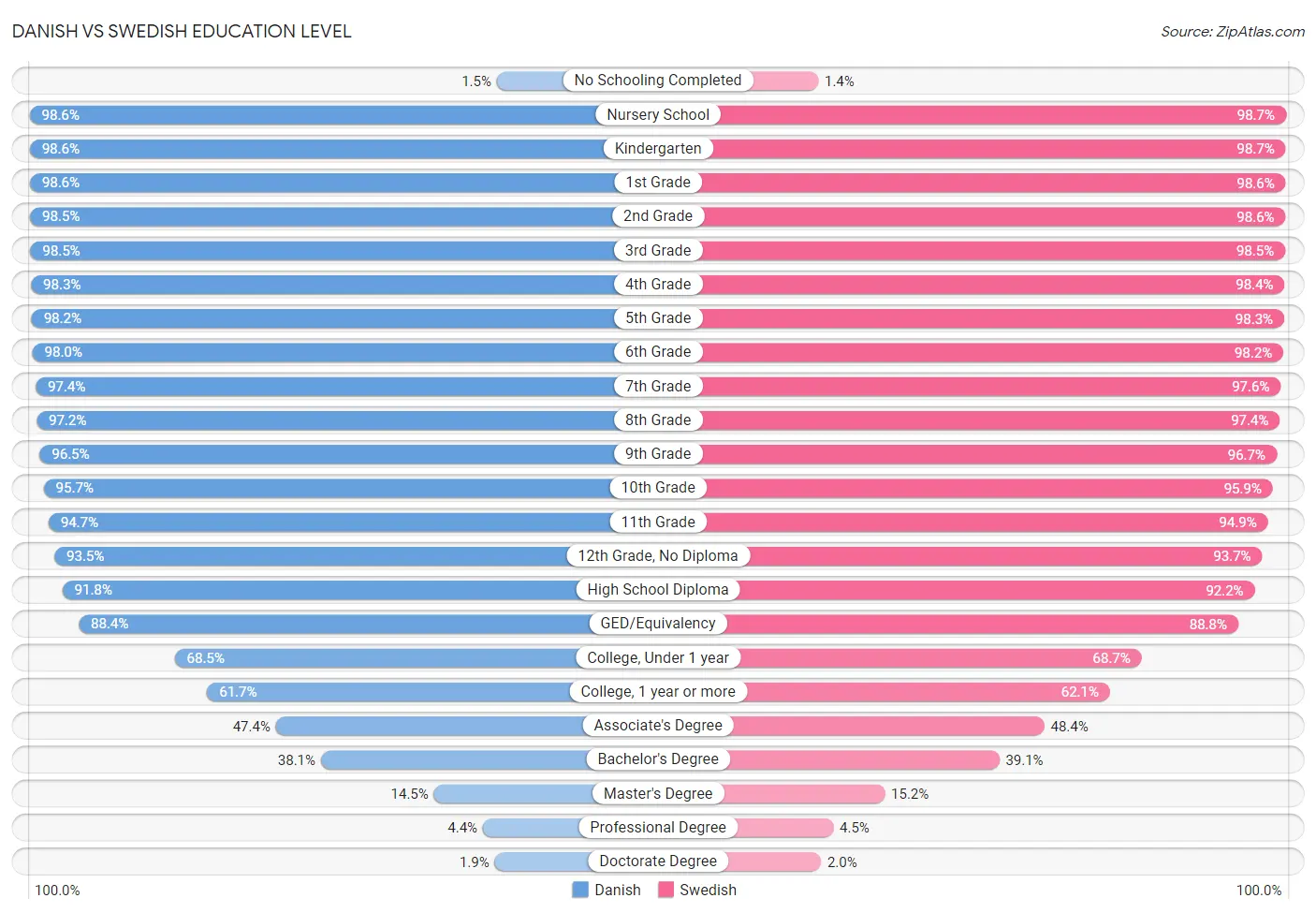
| Education Level Metric | Danish | Swedish |
| No Schooling Completed | Exceptional 1.5% | Exceptional 1.4% |
| Nursery School | Exceptional 98.6% | Exceptional 98.7% |
| Kindergarten | Exceptional 98.6% | Exceptional 98.7% |
| 1st Grade | Exceptional 98.6% | Exceptional 98.6% |
| 2nd Grade | Exceptional 98.5% | Exceptional 98.6% |
| 3rd Grade | Exceptional 98.5% | Exceptional 98.5% |
| 4th Grade | Exceptional 98.3% | Exceptional 98.4% |
| 5th Grade | Exceptional 98.2% | Exceptional 98.3% |
| 6th Grade | Exceptional 98.0% | Exceptional 98.2% |
| 7th Grade | Exceptional 97.4% | Exceptional 97.6% |
| 8th Grade | Exceptional 97.2% | Exceptional 97.4% |
| 9th Grade | Exceptional 96.5% | Exceptional 96.7% |
| 10th Grade | Exceptional 95.7% | Exceptional 95.9% |
| 11th Grade | Exceptional 94.7% | Exceptional 94.9% |
| 12th Grade, No Diploma | Exceptional 93.5% | Exceptional 93.7% |
| High School Diploma | Exceptional 91.8% | Exceptional 92.2% |
| GED/Equivalency | Exceptional 88.4% | Exceptional 88.8% |
| College, Under 1 year | Exceptional 68.5% | Exceptional 68.7% |
| College, 1 year or more | Exceptional 61.7% | Exceptional 62.1% |
| Associate's Degree | Good 47.4% | Exceptional 48.4% |
| Bachelor's Degree | Average 38.1% | Good 39.1% |
| Master's Degree | Fair 14.5% | Good 15.2% |
| Professional Degree | Average 4.4% | Good 4.5% |
| Doctorate Degree | Good 1.9% | Excellent 2.0% |
Danish vs Swedish Disability
When considering disability, the most significant differences between Danish and Swedish communities in the United States are seen in disability age under 5 (1.5% compared to 1.6%, a difference of 7.0%), self-care disability (2.3% compared to 2.3%, a difference of 2.7%), and ambulatory disability (5.8% compared to 6.0%, a difference of 2.4%). Conversely, both communities are more comparable in terms of vision disability (2.1% compared to 2.1%, a difference of 0.010%), disability age 35 to 64 (11.4% compared to 11.4%, a difference of 0.48%), and disability age 18 to 34 (7.5% compared to 7.5%, a difference of 0.56%).
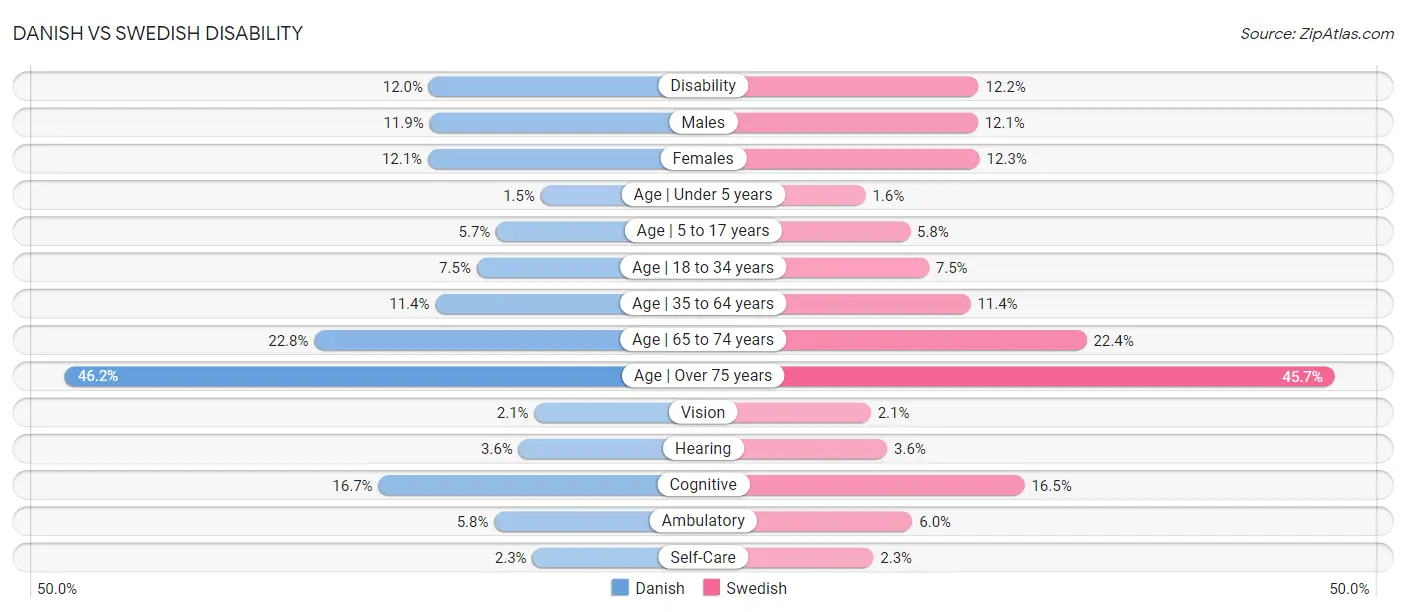
| Disability Metric | Danish | Swedish |
| Disability | Tragic 12.0% | Tragic 12.2% |
| Males | Tragic 11.9% | Tragic 12.1% |
| Females | Good 12.1% | Fair 12.3% |
| Age | Under 5 years | Tragic 1.5% | Tragic 1.6% |
| Age | 5 to 17 years | Fair 5.7% | Tragic 5.8% |
| Age | 18 to 34 years | Tragic 7.5% | Tragic 7.5% |
| Age | 35 to 64 years | Fair 11.4% | Fair 11.4% |
| Age | 65 to 74 years | Excellent 22.8% | Exceptional 22.4% |
| Age | Over 75 years | Exceptional 46.2% | Exceptional 45.7% |
| Vision | Exceptional 2.1% | Exceptional 2.1% |
| Hearing | Tragic 3.6% | Tragic 3.6% |
| Cognitive | Exceptional 16.7% | Exceptional 16.5% |
| Ambulatory | Exceptional 5.8% | Excellent 6.0% |
| Self-Care | Exceptional 2.3% | Exceptional 2.3% |